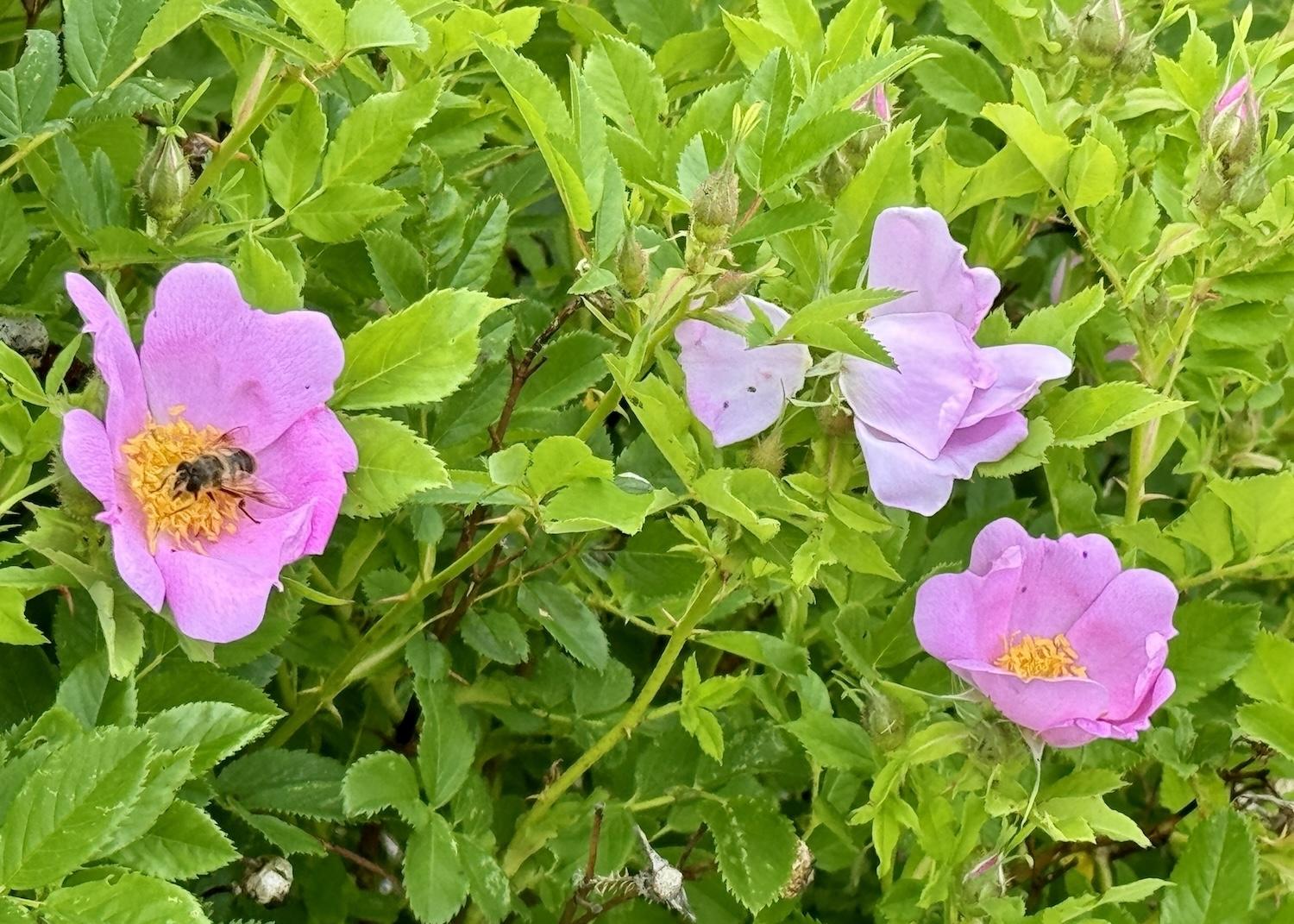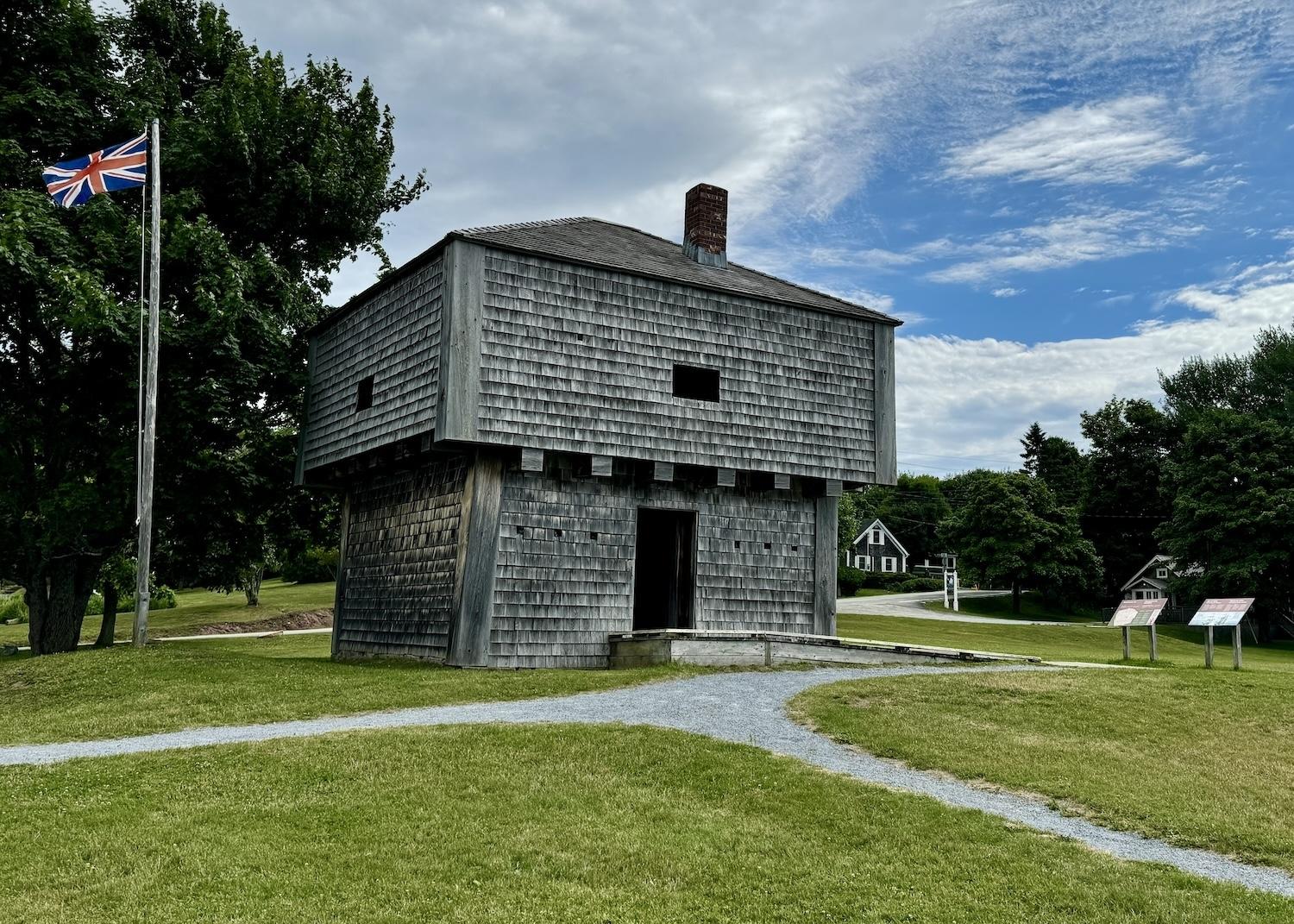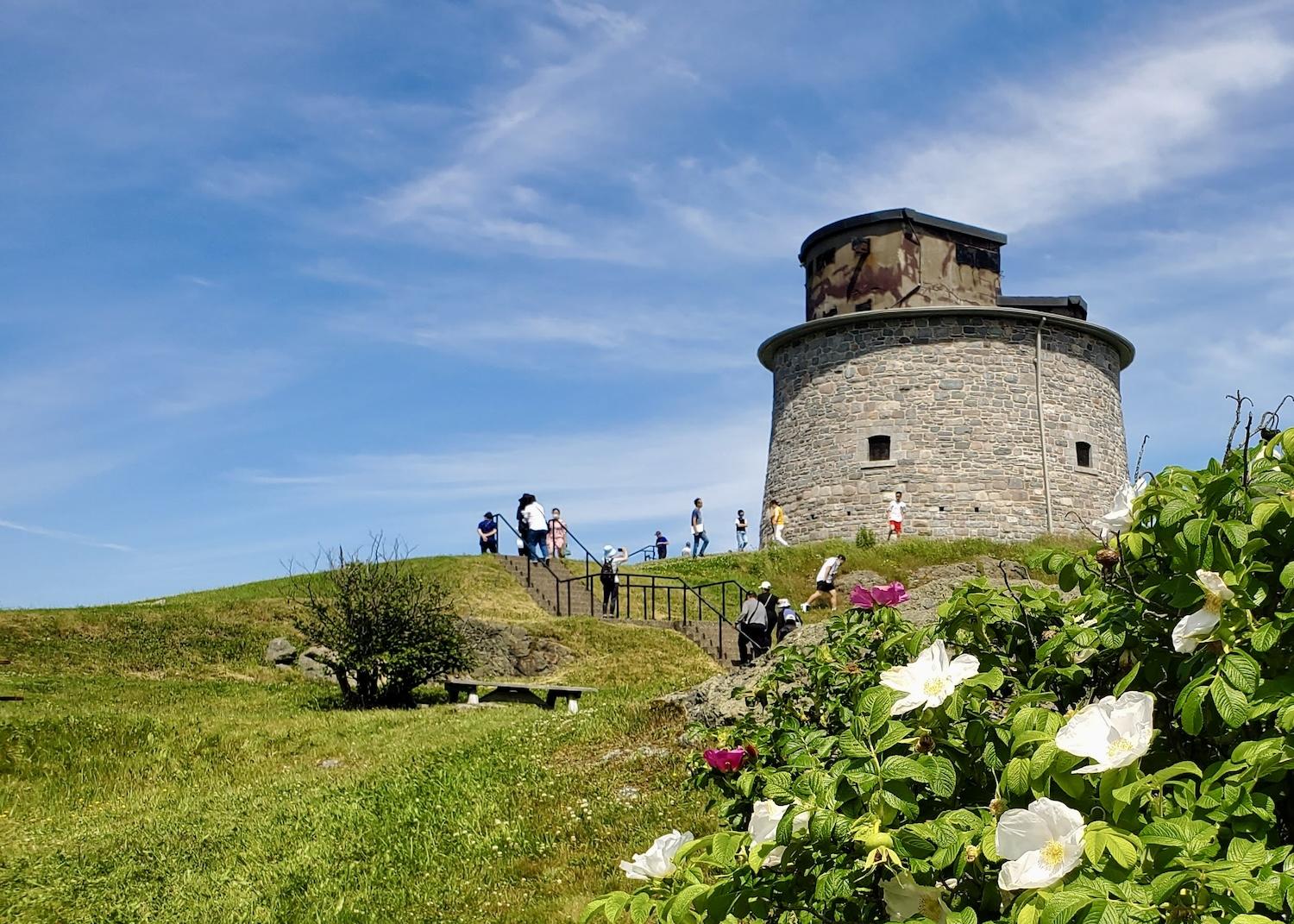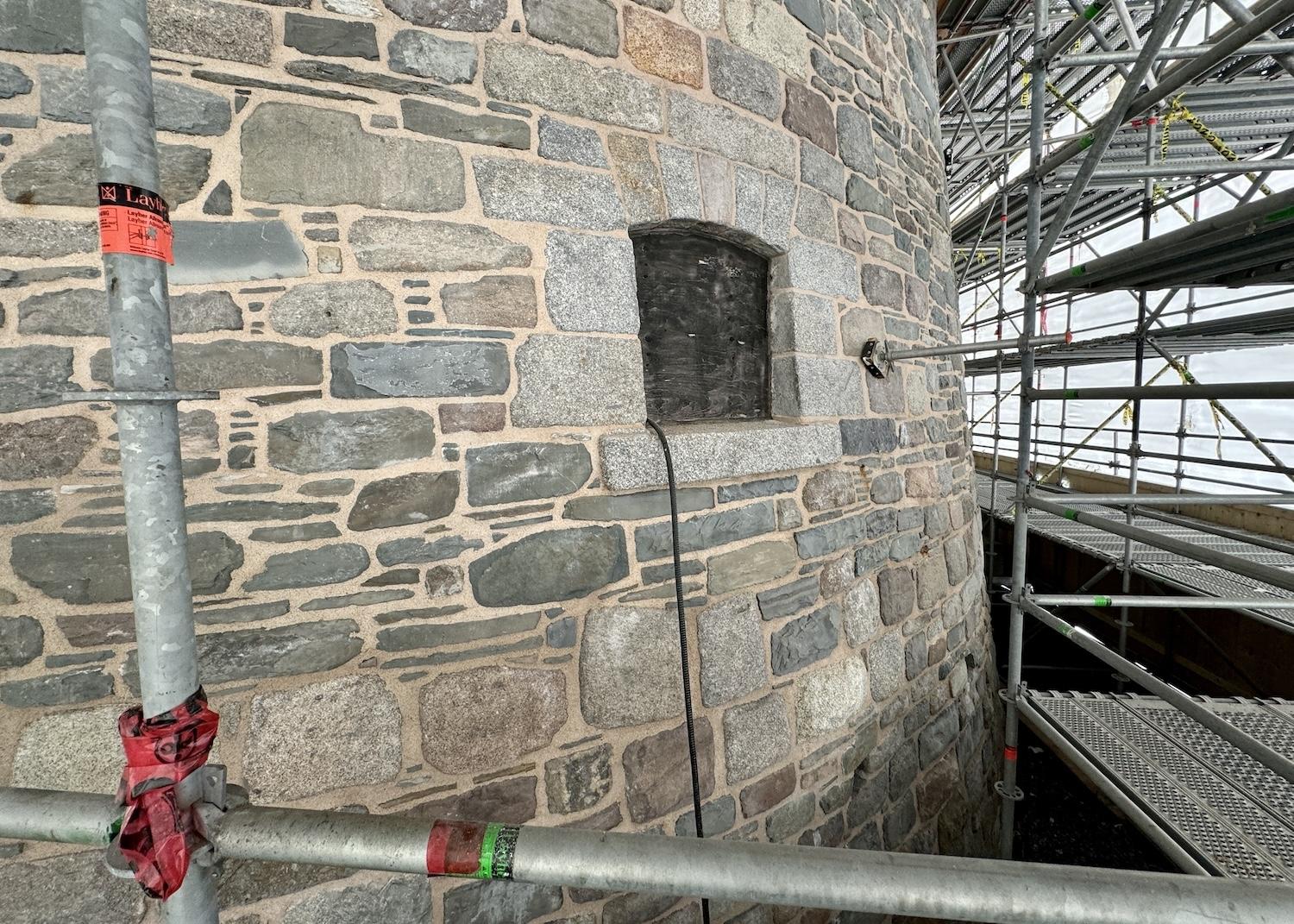As far as pollinator gardens go, the one at St. Andrews Blockhouse National Historic Site is barely bigger than a queen-sized bed. But that’s actually a good thing since it proves the point that anyone with access to an outdoor space — no matter how small — can create a garden and make a difference.
“It looks like the daisies have taken over,” says Kurt Peacock, the historic sites lead for Parks Canada in southern New Brunswick, as he peers over a fence meant to keep the deer at bay. He nods approvingly at the spotted joe-pye weed and shrubby cinquefoil, and the bees swarming the Virginia roses.
“When I come here and see the bees thriving, I’m really happy.”

Bees enjoy the roses at the St. Andrews Blockhouse National Historic Site pollinator garden/Jennifer Bain
Peacock “made the case” that national historic sites — not just national parks — should get to plant these gardens. “The one at Fundy National Park is probably 15 times bigger, but I was really, really happy to get this one. Obviously, it adds greenery to our site, but it also provides a very important message to the public about the role of pollinators.”
We probably picture monarch butterflies and yellow-banded bumble bees when we think of pollinators, but all kinds of butterflies, bees, flies, moths, mice and birds perform the same vital service to our planet. They help plants reproduce by carrying pollen from flower to flower, allowing them to produce fruits, seeds and nuts.
Around the world, though, many pollinators are under serious threat due to loss of habitat and food sources, pesticides, pollution, diseases and climate change. Landscape fragmentation, urban development, roads, forestry and industrial agriculture aren’t helping.

Kurt Peacock, the historic sites lead for Parks Canada in southern New Brunswick, checks on the pollinator garden at St. Andrews Blockhouse/Jennifer Bain
“Threats to pollinator populations is a major problem for humans,” warns a sign at the blockhouse garden. “Almost all of the food that we eat depends upon the work of pollinators.”
But there’s hope. Typical yards and balconies can become “stepping stones” for pollinators as they move between parks and other protected areas.
We’ve finally ditched our grass lawn and transformed the front yard of our Toronto home into a pollinator garden, which is really just a carefully planned outdoor space that’s welcoming to pollinators and full of plants native to your region.

The blockhouse is the focal point of St. Andrews Blockhouse National Historic Site, but it's just steps from a small but important pollinator garden/Jennifer Bain
When I travel, I’m drawn to gardens — I wrote this story about the one in Fundy — and love how Parks Canada has kept the messaging short and upbeat on signage here at the blockhouse.
“Create your own” native garden, it urges the 10,000 people who visit each year. “Embrace chaos” by letting your garden grow wild to give pollinators a place to hide. “Resist raking leaves” and let a corner of your yard go unmowed.
Help scientists by uploading pollinator photos to iNaturalist. Limit your waste. Take action against climate change. Check. Check. Check.

Parks Canada's Kurt Peacock shows how the agency has tried to make the shoreline more resilient to climate change at St. Andrews Blockhouse/Jennifer Bain
Speaking of climate change, the effects of that are unfortunately on full display when I visit the blockhouse and walk along the shore with Peacock.
The blockhouse — an imposing, square, wooden defensive structure whose second floor overhangs the ground floor — dominates a green space overlooking the harbor and waterfront of the tourist town of St. Andrews. You can even see Maine from the site.
The building is associated with the defence of British North America against American privateers and military forces during the War of 1812. Funded and built by local citizens with militia support, it was the only privately financed fortification of the war. It didn’t see active service, though, and was used as barracks for the local garrison.

You can still see evidence of a 1993 arson in St. Andrews Blockhouse/Jennifer Bain
After a 1993 arson destroyed the roof, burned off some of the shingle siding, damaged second-floor boards and beams, charred the interior walls and rounded and increased the dimensions of some of the loophole and porthole openings, Parks Canada restored the blockhouse.
Blockhouses were a quick and inexpensive method of protection and this is one of the oldest surviving examples in Canada. It was declared a national historic site in 1962.
“These sites take quite a battering,” Peacock admits. “The climate is changing and there are real risks of coastal erosion. We’ve built a brick retainer wall of sorts.” As we walk along the sea looking for it, he realizes a stairwell has been swept away.
“Nature always wins. We can build significant structures to protect our sites but nature is always a very powerful force.”

Parks Canada's Kurt Peacock stands by the sea by a wall that's meant to combat coastal erosion/Jennifer Bain
I spend a few minutes inside the blockhouse, chatting with student interpreter Ryan Lacey, but I’m honestly more fascinated by pollinator gardens than military history. When Peacock says there’s another pollinator garden an hour away at Carleton Martello Tower National Historic Site in Saint John, I’m game to continue our chat there.
I’d almost written off Carleton Martello on my New Brunswick road trip in July because the aging tower has been closed for eight years for public safety and a rehabilitation project, and simply visiting the visitor center and exhibit gallery didn’t have huge appeal.
But who doesn’t find scaffolding strangely beautiful?

The Carleton Martello Tower has been wrapped in scaffolding for phase two of a lengthy rehabilitation project/Jennifer Bain
Carleton Martello Tower is a stone fort that dates back to the War of 1812 and is topped with a Second World War command post. It sits on a 2.89-acre plot of steep, rocky, open ground in the Saint John neighborhood of Carleton Heights.
The landmark tower is about 225 feet above sea level at its highest point and offers sweeping views of uptown Saint John, the harbor and the Bay of Fundy. The site drew 5,769 visitors last year and most people come for the view.
“One of the ironies of our tourist season is that the bulk of our visits take place in the fall and are driven by American cruise ships,” confides Peacock. “We had built this tower to protect this city from American invasion but now a good chunk of our visitation is made up of Americans — who we gladly welcome.”

A concrete addition to the top of Carleton Martello Tower during World War II put significant stress on the heritage building/Parks Canada
But, as Parks Canada points out, the tower has been plagued by leaks, battered by “cold winds and rain that sweep off the Bay of Fundy,” and stressed by the weight of the two-storey concrete fire command post added to its top in the Second World War.
Investigative work in 2015 revealed the tower was “in a state of critical failure” and so Canada committed to rehabilitate it in phases.
Phase one focused on masonry work and was handled by Groupe Atwill-Morin from Montreal, Quebec, who specialize in heritage building restoration. They stabilized the tower by restoring the exterior wall of the tower, stone by stone.

A sneak peek at the restoration work being done at the top of Carleton Martello Tower/Jennifer Bain
For the second and final phase of the rehabilitation work, the fire command post atop the tower is being replaced with a light-weight replica of the original. There will also be a new roof and a new heating and humidity control system.
“There was a recognition that we had to lighten the load on that tower,” Peacock explains. Thin concrete veneer will lighten the load by 50 per cent. Heritage window shutters have been removed and are now being restored.

Inside the construction zone, you can see where a heritage window has been removed and where the stones have been removed, cleaned and returned/Jennifer Bain
What's really cool, though, is that several of these vintage concrete pieces have been earmarked for the pollinator garden, which is currently behind the construction fence and off-limits to visitors.
“We have kept concrete pieces and will add them as design elements in the garden,” says Peacock as we tour the site.
In the excitement of getting to go behind the scaffolding and climb ot the top of the tower, I don’t study the pollinator garden as closely as I should. But I see that it's fenced and safely tucked behind stacked pallets of carefully numbered stones. Just like the blockhouse garden, it’s only about the size of a queen-sized bed but still doing its vital work for the planet.

On the edge of construction at Carleton Martello Tower, the pollinator garden manages to thrive/Jennifer Bain



 Support Essential Coverage of Essential Places
Support Essential Coverage of Essential Places






